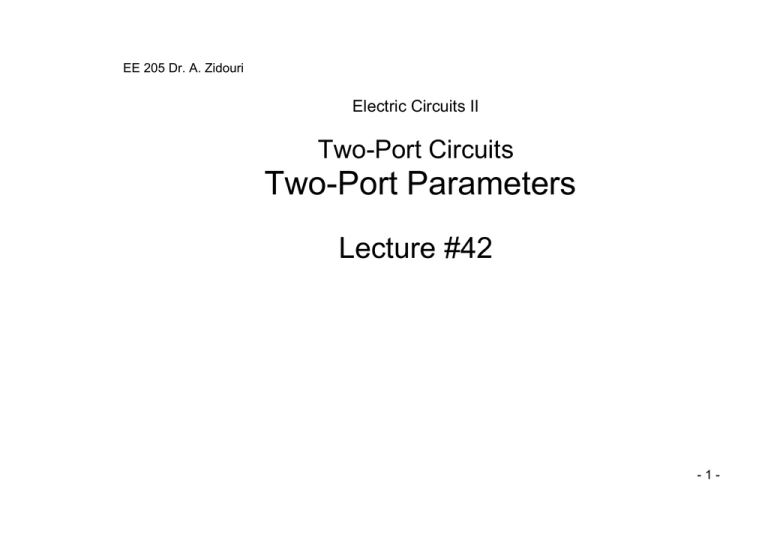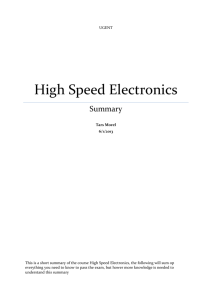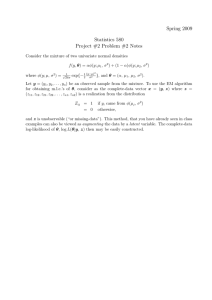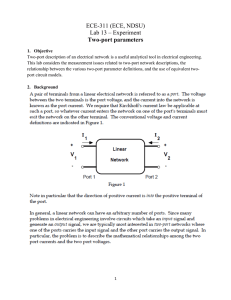Two-Port Parameters
advertisement

EE 205 Dr. A. Zidouri Electric Circuits II Two-Port Circuits Two-Port Parameters Lecture #42 -1- EE 205 Dr. A. Zidouri The material to be covered in this lecture is as follows: o o o o Introduction to two-port circuits The Terminal Equations The Two-Port z-parameters The Two-Port y-parameters -2- EE 205 Dr. A. Zidouri After finishing this lecture you should be able to: ¾ ¾ ¾ ¾ Understand the Importance of Two-Port Circuits Relate the Current and Voltage at One Port to the Current and Voltage at the Other Port. Determine the Two-Port z-parameters Determine the Two-Port y-parameters -3- EE 205 Dr. A. Zidouri Introduction to Two-Port Circuits In analyzing some electrical systems, focusing on two pairs of terminal is convenient. Often, a signal is fed into one pair of terminals and then after being processed, is extracted at a second pair of terminals. The terminal pairs represent the points where signals are either fed in or extracted. They are referred to as ports of the system. Fig. 42-1 illustrates the basic two-port building block. Use of this building block is subject to several restrictions: o There can be no energy stored within the circuit o There can be no independent sources within the circuit o The current into the port must equal the current out of the port o All external connections must be made to either the input port or output port, no connections are allowed between the ports. The fundamental principle underlying two-port modeling of a system is that only the terminal variables (i1, v1, i2, and v2) are of interest. -4- EE 205 Dr. A. Zidouri The Terminal Equations In two-port network we are interested in relating the current and voltage at one port to the current and voltage at the other port. Fig. 42-1 shows the reference polarities of the terminal voltages and the reference directions of the terminal currents. Most general description is carried out in the s domain. We write all equations in the s domain, resistive networks and sinusoidal steady state solutions become special cases. Fig. 42-2 shows the basic building block in terms of the s-domain variables I1, V1, I2, and V2. I2 I1 V1 V2 Fig. 42-2 The s-domain Two-Port Basic Building Block Out these four terminal variables, only two are independent. Thus we can describe a two-port network with just two simultaneous equations. However there are six ways in which to combine the four variables: Impedance Parameters (z-parameters): V1 = z11 I1 + z12 I 2 V2 = z21 I1 + z22 I 2 (42-1) -5- EE 205 Dr. A. Zidouri Admittance Parameters (y-parameters): Hybrid Parameters (h-parameters): Inverse Hybrid Parameters (g-parameters): Transmission Parameters (a-parameters): Inverse Transmission Parameters (b-parameters): I1 = y11V1 + y12V2 I 2 = y21V1 + y22V2 V1 = h11 I1 + h12V2 I 2 = h21 I1 + h22V2 I1 = g11V1 + g12 I 2 V2 = g 21V1 + g 22 I 2 V1 = a11V2 − a12 I 2 I1 = a21V2 − a22 I 2 V2 = b11V1 − b12 I1 I 2 = b21V1 − b22 I1 (42-2) (42-3) (42-4) (42-5) (42-6) These six sets of equations may also be considered as three pairs of mutually inverse relations. The coefficients of the variables are called the parameters of the two-port circuit. We refer to the z-parameters, y-parameters, a-parameters, b-parameters, h-parameters and g-parameters of the network. -6- EE 205 Dr. A. Zidouri The Two-Port Parameters z-parameters: V1 = z11 I1 + z12 I 2 V2 = z21 I1 + z22 I 2 or in matrix form: ⎡V1 ⎤ ⎡ z11 ⎢V ⎥ = ⎢ z ⎣ 2 ⎦ ⎣ 21 z12 ⎤ ⎡ I1 ⎤ ⎡ I1 ⎤ = z [ ] ⎢I ⎥ z22 ⎥⎦ ⎢⎣ I 2 ⎥⎦ ⎣ 2⎦ (42-7) The values of the parameters can be evaluated by setting I1=0 (input port open-circuited) or I2=0 (output port open-circuited). Thus, z11 = z21 = V1 V , z12 = 1 I1 I =0 I 2 I =0 2 1 (42-8) V2 V , z22 = 2 I1 I =0 I 2 I =0 2 1 The z-parameters are also called the open-circuit impedance parameters: ¾ z11= Open-circuit input impedance ¾ z12= Open-circuit transfer impedance from port 1 to port 2 ¾ z21= Open-circuit transfer impedance from port 2 to port 1 ¾ z22= Open-circuit output impedance Example 42-1 illustrates the determination of the z-parameters for a resistive circuit. -7- EE 205 Dr. A. Zidouri Example 42-1 Find the z-parameters for a resistive circuit shown in Fig. 42-3 Solution: To obtain z11 and z21 we connect a voltage V1 (or a current source I1) to port 1 with port 2 open circuited as in Fig. 42-4a. i1 i2 v1 v2 Fig. 42-3 The Circuit for Example 42-1 z11 = 20 × 20 V1 = = 10Ω , 40 I1 I =0 2 When I2 is zero, V2 = V1 V 0.75V1 × 20 15 = 0.75V1 therefore z21 = 2 = = 7.5Ω 15 + 5 I1 I =0 V1 10 2 To obtain z12 and z22 we connect a voltage V2 (or a current source I2) to port 2 with port 1 open circuited as in Fig. 42-4b. -8- EE 205 Dr. A. Zidouri I2 I1=0 V2 v1 Fig. 42-4b Circuit for finding z12 an z22 z22 = 15 × 25 V2 = = 9.375Ω , 40 I 2 I =0 1 When I1 is zero, V1 = V2 V 0.8V2 V = = 7.5Ω ( 20 ) = 0.8V2 and I 2 = 2 hence z12 = 1 5 + 20 I 2 I =0 V2 9.375 9.375 1 Note that each of these parameters is the ratio of a voltage to a current and therefore is an impedance with the dimension of ohms; this is why they are called z-parameters. When z11 = z22 , the two-port network is said to be symmetrical. When the two-port network is linear and has no dependent sources, the transfer impedances are equal (z12=z21), and the two-port network is said to be reciprocal. -9- EE 205 Dr. A. Zidouri I1 = y11V1 + y12V2 y-parameters: I 2 = y21V1 + y22V2 or in matrix form: ⎡ I1 ⎤ ⎡ y11 ⎢I ⎥ = ⎢ y ⎣ 2 ⎦ ⎣ 21 y12 ⎤ ⎡V1 ⎤ ⎡V1 ⎤ = y [ ] ⎢V ⎥ y22 ⎥⎦ ⎢⎣V2 ⎥⎦ ⎣ 2⎦ (42-9) The values of the parameters can be evaluated by setting V1=0 (input port short-circuited) or V2=0 (output port short-circuited). Thus, y11 = y21 = I1 I , y12 = 1 V1 V =0 V2 V =0 2 1 (42-10) I2 I , y22 = 2 V1 V =0 V2 V =0 2 1 The y-parameters are also called the short-circuit admittance parameters: ¾ y11= Short-circuit input admittance ¾ y12= Short -circuit transfer admittance from port 2 to port 1 ¾ y21= Short -circuit transfer admittance from port 1 to port 2 ¾ y22= Short -circuit output admittance Example 42-2 illustrates the determination of the y-parameters for a resistive circuit. - 10 - EE 205 Dr. A. Zidouri Example 42-2 Obtain the y-parameters for the resistive circuit shown in Fig. 42-5 Solution: To obtain y11 and y21 we connect a current I1 (or a voltage source V1) to input port 1 with output port 2 short circuited as in Fig. 426a. y11 = I1 I1 I = = 1 = 0.75S , 4 I V1 V =0 I1 ( 4 2 ) V2 =0 3 1 V2 =0 2 ( ) ( ) − 2 I1 4 2 4 I2 3 When V2 is zero, − I 2 = I1 = I1 and V1 = I1 hence y21 = = = −0.5S 4 I V1 I =0 4+2 3 3 2 3 1 I2 =0 - 11 - EE 205 Dr. A. Zidouri To obtain y12 and y22 we connect a current source I2 (or a voltage source V2) to port 2 with port 1 short circuited as in Fig. 42-6b. y22 = I2 I2 = V2 V =0 I 2 ( 8 2 ) 1 When V1 is zero, − I1 = = V2 =0 I2 8 I 5 2 V1=0 = 0.625S −0.8 I 2 I I2 8I = = −0.5S (8 ) = 0.8I 2 and V2 = 2 hence y12 = 1 V2 V =0 1.6 I 2 V =0 8+ 2 5 1 1 Note that each of these parameters is the ratio of a current to a voltage and therefore is an admittance with the dimension of siemens; this is why they are called y-parameters. - 12 - EE 205 Dr. A. Zidouri Self Test 42: a) Determine the z-parameters for the circuit in Fig. 42-7 b) Determine the y-parameters for the circuit in Fig. 42-8 Fig. 42-7 Circuit for self test 42a Fig. 42-8 Circuit for self test 42b Answer: a) z11 = 60Ω z12 = 40Ω z22 = 70Ω z21 = 40Ω b) y11 = 0.2273S y12 = y21 = −0.0909 S y22 = 0.1364S - 13 -


